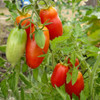San Marzano Tomato Seeds - (Lycopersicon lycopersicum)
- SKU:
- V1276
- Seed Count:
- Approx 25 seeds per pack
- Days to Maturity:
- 70-90 days
- Type:
- Indeterminate
- Size:
- Plum
- Color:
- Red
- Days to Germination:
- 5-7 days @ 75-95F
- Light Preference:
- Full sun
- Plant Spacing:
- 12"
- Status:
- Heirloom, Non-Hybrid, Non-GMO seeds
Description
San Marzano Tomato - Because Your Pasta Deserves the Best
The San Marzano tomato is the undisputed champion of the tomato sauce world. This elegant Italian heirloom graces your garden with loads of elongated fruits having dense, meaty flesh; it's a flavor powerhouse featuring intense sweetness with balanced acidity, yielding luscious, thick sauces. The fruits are low in water with few seeds, making them the secret ingredient for crafting concentrated, smooth sauces that burst with authentic Italian flavor. Italians love them so much they’ve been awarded the prestigious DOP (Denominazione d'Origine Protetta) status, indicating they meet strict regulations regarding their origin, production methods, and quality, ensuring authentic flavor and adherence to traditional practices.
Don’t think that San Marzanos are only for sauce – they’re highly versatile and delicious, sliced fresh on salads, roasted for vibrant salsas, or sun-dried for a taste of the Mediterranean sun. They are the original tomatoes in the famous Caprese dish – San Marzano tomatoes, fresh mozzarella, and freshly picked basil leaves – showcasing the colors of the Italian flag. Disease-resistant and thriving in warm climates, these low-maintenance beauties reward you with generous harvests throughout the season.
By the 1920s, the San Marzano tomato from Italy set a new standard, marking a turning point for the California tomato canning industry, allowing for the production of canned tomatoes that were superior in taste and texture, and ultimately led to an increase in demand for this beloved fruit.
The San Marzano fruit is distinctive, elongated teardrop shapes with pointed ends, epitomizing the elegant Italian plum tomato! Their dense, meaty flesh holds fewer seeds than other varieties, ideal for sauces due to high fruit concentration. The vines themselves are indeterminate, growing tall and bearing fruit throughout the season. While demanding support, they reward patient gardeners with abundant harvests all season long.
History
The history of how wild tomato species became our modern domesticated varieties has been debated and revised several times. New scientific findings have contributed to this ongoing debate. Previously, it was believed that the cultivation of wild tomato ancestors began in South America around 7,000 years ago. These plants were bred to produce slightly larger fruits like cherry tomatoes. Later, they were further domesticated in Mesoamerica, producing our modern-sized tomatoes.
However, recent genetic research suggests that cherry-sized tomatoes first grew naturally in Ecuador around 80,000 years ago, without human intervention. Humans in South America later cultivated these early tomatoes but did not develop the larger fruit size we see today. Over time, these cherry-sized fruits spread northward towards Mesoamerica through human movement, birds, or a combination of natural routes.
After many years of persistence as weedy, semi-domesticated plants, their fruits changed significantly to resemble South America's more petite wild tomatoes from 80,000 years ago. Eventually, these smaller fruited plants were domesticated in Mesoamerica (around 7,000 years ago) into our modern tomato.
The tomato's journey to the rest of the world began with the arrival of Christopher Columbus in the New World. He discovered the tomato and brought it back to Spain in the late 15th century. Despite initial resistance and skepticism in Europe, the tomato began gaining acceptance as a food in the 18th century. Italy quickly embraced it, becoming a staple ingredient in many dishes, including pizza and pasta sauces.
The tomato made its way to North America in the early 18th century, but it was in the mid-19th century that it became widely cultivated. Today, the tomato is one of the most beloved vegetables in the world, cherished for its delectable taste, nutritious benefits, and versatility in cooking.
Uses
Raw or cooked the tomato is one of the most widely used and versatile foods from your garden. Use fresh in salads, sandwiches, and salsas. Cooked in sauces and stews. Can be stuffed, dried, puree, paste or powdered. The uses are endless!
Growing Tip
Tomatoes take about 3 - 4 months from direct seeding in the garden to start producing fruit; about 70 days from transplanting 6 - 8 week-old plants to start fruiting; and about 40-50 days from the flower opening to producing ripe fruit.
Tomatoes suffer more transplant shock than other vegetables, but you can minimize this by hardening them off for a week or two first. This means setting them outdoors in their pots in a protected place so that they get some warm sun, a little gentle wind, and even some cool (not freezing) nights. This will help them adjust to some of the stresses of real life before having their roots transplanted into the ground.
Tomatoes begin the ripening process by producing ethylene, a natural growth regulator, and releasing it. The fruit ripens from the inside out, meaning the center matures and turns red before the color reaches the outer skin. Faint white lines crossing each other at the bottom or blossom end of the fruit show that ripening has begun. Soon afterward, the blossom end starts turning pink – indicating ethylene is being produced. When the pink blush reaches the stem, the fruit is about 75% ripe. The pink color deepens to red, starting from the blossom end and working its way upward.
Harvest Tip
A tomato’s flavor increases as it ripens, due to the increased nutrients and sugars pumped into the fruit by the plant. For a home gardener, harvesting when there is just a touch of pink at the stem end or when the fruit is completely red gives the best flavor. The fruit will be fragile, won’t tolerate shipping and must be used or cooked within a few days to enjoy peak flavor.
Once the tomato is ripe, test by giving it a gentle pull or twist. If it slips easily from the vine – with little to no effort – it is ripe, juicy, and delicious!
Ripe tomatoes can be injured by cool temperatures and must be stored at room temperatures, never refrigerated to avoid chilling injury, which leaves pockmarks or pits on the skin leading to early rotting.
If you need to harvest early due to weather or the end of the season, those fruits with a pink blush at the blossom end will ripen with almost full flavor. Those with the faint white lines can still ripen but won’t have the full flavor.
Learn More
- World Famous San Marzano Tomatoes
- Make the Best Sun-Dried Tomatoes at Home
- Growing Tomatoes 101
- Determinate and Indeterminate Tomatoes - What's the Difference?
- Heirloom Tomato Growing Tips
- Heirloom Tomato Leaves - Potato Leaf vs Regular Leaf
- Blossom End Rot - What To Do
- Fermented Tomato Conserve
- Sicilian Eggplant and Tomato Sauce
From the soil to the seed to the food you eat - we'll help you grow your best garden!
2 Reviews
-
Great for sauce
This tomato makes a fabulous sauce. Heavy performer, good size fruit. Didn't give it five stars because it isn't very disease resistant. All the lower leaves wilted. Didn't seem to affect performance, however.
-
Huge Harvest!
Every time I grow San Marzano I am amazed at the huge harvest. This year has been no exception. When other tomatoes are just putting out flowers San Marzano has already produced delicious ripe tomatoes. When other varieties have stopped producing San Marzano just keeps on giving. If you have a limited amount of space, but would still like a big harvest of an excellent paste tomato then this is one Id grow for sure. This is a very hardy variety. I have grown it for years, and know it withstands all sorts of un-ideal conditions from garden pests to extreme weather conditions. An all around winner in my book.

















